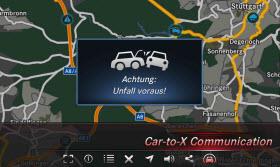 In a connected car field trial currently taking place in Ann Arbor, Mich., the National Highway Traffic Safety Administration is testing safety technology that allows cars “talk” to the road and one another. By the end of the year, NHTSA will decide whether to mandate the technology for all new cars.
In a connected car field trial currently taking place in Ann Arbor, Mich., the National Highway Traffic Safety Administration is testing safety technology that allows cars “talk” to the road and one another. By the end of the year, NHTSA will decide whether to mandate the technology for all new cars.
While eight automakers are involved with the NHTSA test, hundreds of existing automobiles were retrofitted to take part in the test -- proving that older cars can also join the conversation. Cohda Wireless, the company that supplies some of the devices, said the technology can be easily adopted by the aftermarket for use on existing vehicles, and in some cases, a driver’s smartphone can be used to connect to other cars.
Mercedes-Benz also recently introduced an aftermarket add-on kit that will allow its vehicles to talk to one another later this year, and parent company Daimler plans to expand the technology to other automotive brands. For now, it’s available only in Europe, and it works only with an iPhone.
The NHTSA test uses Dedicated Short Range Communications (DSRC), a form of connectivity that’s similar to Wi-Fi and that the agency says is “fast, secure, reliable, and unlikely to be vulnerable to interference” and can be implemented with “either in-vehicle or aftermarket devices.”
Paul Gray, CEO of Cohda Wireless, told MSN Autos that NHTSA estimated that if just 10 percent of vehicles on the road were fitted with DSRC to talk to other vehicles and traffic infrastructure -- collectively known as car-to-x communication -- there would be a measurable reduction in the number of accidents.
That’s why the 256 vehicles involved in the test contain aftermarket safety features co-developed by Cohda. The company collaborated with automotive supplier Delphi on 150 of these retrofit devices.
“These would be installed in existing vehicles, and use an LCD screen embedded in the rear-vision mirror, in the same way as aftermarket backup cameras, to provide warnings to the driver,” Gray said.
On 100 of the test vehicles, Cohda installed some of the safety applications on Android devices that could provide warnings to the drivers through a connected smartphone. The remaining six were used on motorcycles. “Screen-based driver interaction is less effective here,” Gray said, “so this would use audio-only warnings provided by speakers in the rider’s helmet.”
While Cohda doesn’t make an aftermarket product, Gray said the company is starting to see interest among aftermarket equipment suppliers, and his company is targeting car-to-x products that would sell for less than $500.
Mercedes-Benz will also bring the technology to its drivers by the end of this year via its Drive Kit Plus add-on accessory, which works with the Digital DriveStyle iPhone app.
Parent company Daimler called Drive Kit Plus, which initially was used to bring cloud-based infotainment content into the car through a connected smartphone, “the quickest way to deploy the future technology and therefore also the quickest possible shortcut to unlocking the safety potential of car-to-x technology.”
Drive Kit Plus allows a vehicle to receive warning messages issued in the vicinity when, for example, an accident or stalled vehicle is nearby, creating an unseen hazard. It also allows a driver to press a button in a car equipped with the Drive Kit Plus to send a warning message to all vehicles in the area that have the technology.
Drive Kit Plus can be ordered for new vehicles and installed in existing vehicles for about $900. In addition to outfitting its own vehicles with car-to-x technology by the end of this year via Drive Kit Plus, Daimler said in a statement that it is "also maintaining close ties" with other automakers and automotive suppliers. “Ideally car-to-x technology could be fitted as quickly as possible and in as many maintenance vehicles, police or emergency services vehicles as possible,” Daimler said.
But in a truly ideal world, such add-on safety technology would be available at more reasonable costs to anyone in any car, not just for Mercedes-Benz vehicles in Europe or only for those who own an iPhone and have $900 to spend.
Doug Newcomb has been covering car technology for more than 20 years for outlets ranging from Rolling Stone to Edmunds.com. In 2008, he published his first book, "Car Audio for Dummies" (Wiley). He lives and drives in Hood River, Ore., with his wife and two kids, who share his passion for cars and car technology, especially driving and listening to music.
Source: MSN
No comments:
Post a Comment